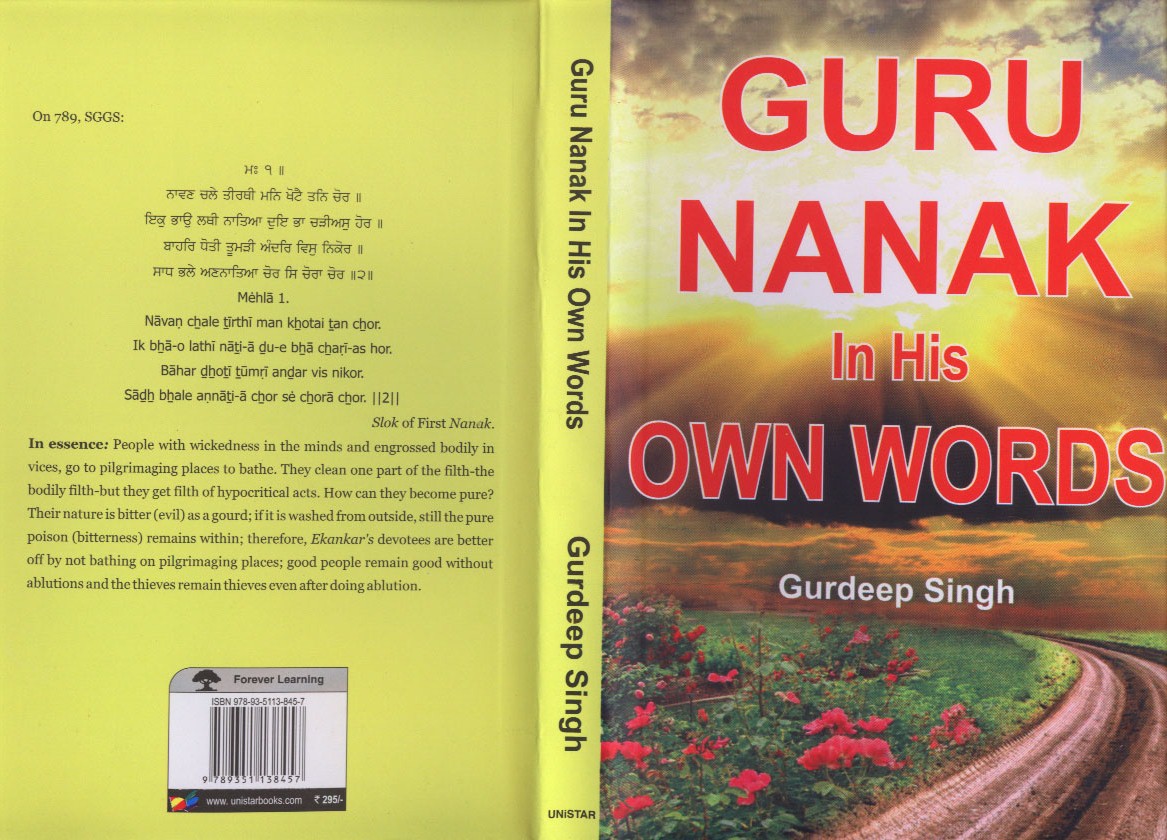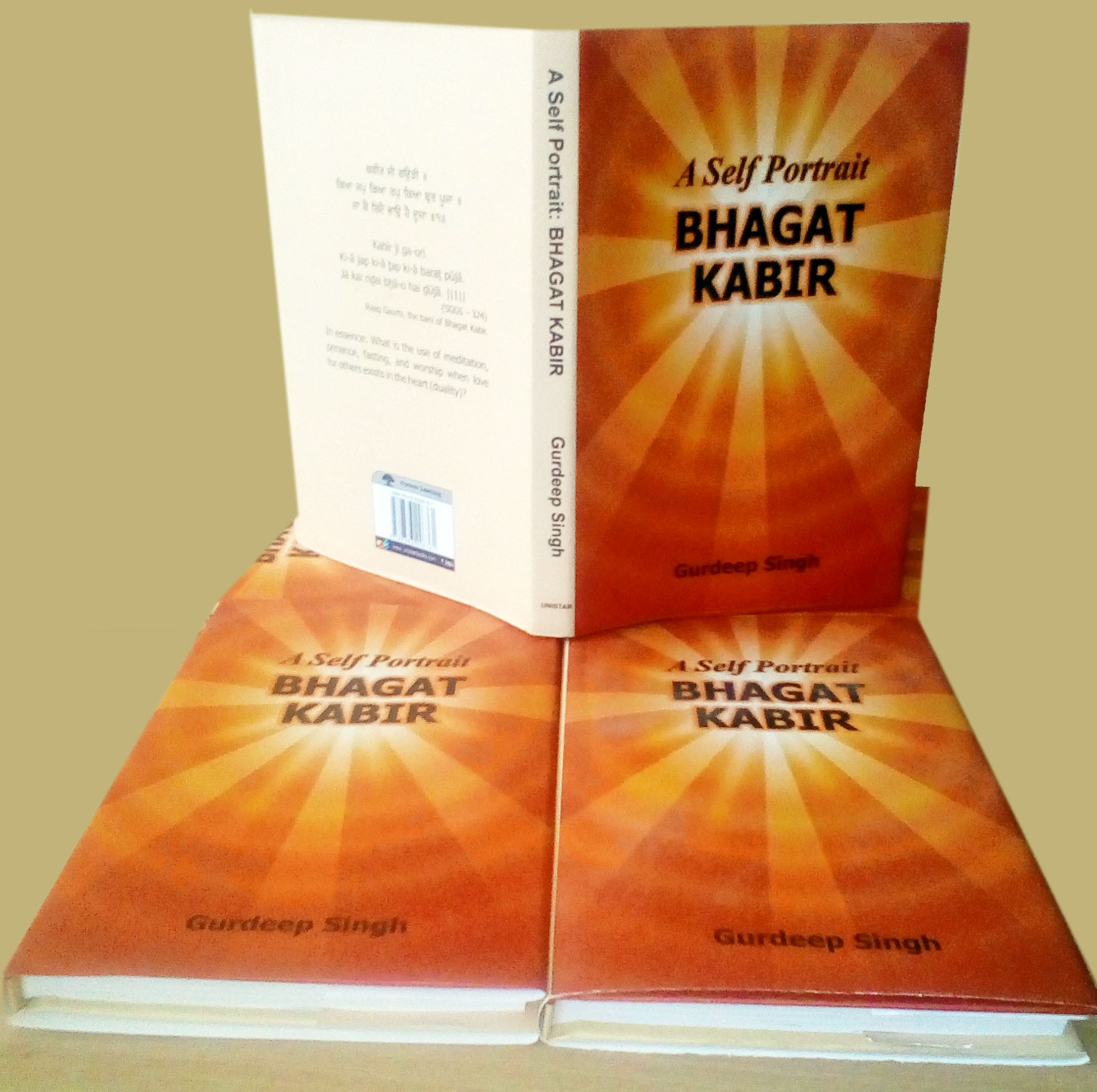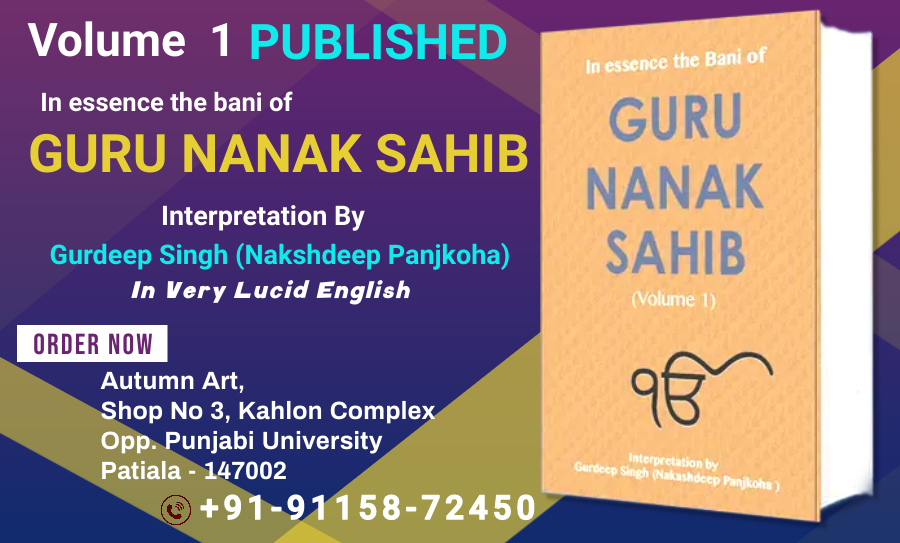Most of us, who talk or write about Prabh’s Simran, fail to figure out how actually Prabh is loved. Go and search the internet, you will find definitions about Prabh and His Simran. I cannot tell better than what is already there on internet; however, I can share with you what I see through Gurbani. Today I am going to elaborate a shabda by Bhagat Namdev who beautifully expresses how the concentration of our minds should remain fixed on our Creator even while working, playing and doing daily chores, and bear this in mind that the Gurus also stress repeatedly on this practice. The Shabda is on 972, Sri Guru Granth Sahib; let us enjoy it in depth and decipher its application to figure out what truly means by meditation in Gurbani.
ਆਨੀਲੇ ਕਾਗਦੁ ਕਾਟੀਲੇ ਗੂਡੀ ਆਕਾਸ ਮਧੇ ਭਰਮੀਅਲੇ ॥
Ānīle kāgaḏ kātīle gūdī ākās maḏẖe bẖarmī▫ale.
In Essence (this shabda is addressed to Trilochan): a boy brings paper, cuts it, makes a kite and then flies it in the sky;
ਆਨੀਲੇ = ਲਿਆਂਦਾ। ਕਾਟੀਲੇ = ਕੱਟ ਕੇ ਬਣਾਈ। ਮਧੇ = ਵਿਚ। ਭਰਮੀਅਲੇ = ਉਡਾਈ।
(ਹੇ ਤ੍ਰਿਲੋਚਨ! ਵੇਖ, ਮੁੰਡਾ) ਕਾਗ਼ਜ਼ ਲਿਆਉਂਦਾ ਹੈ, ਉਸ ਦੀ ਗੁੱਡੀ ਕੱਟਦਾ ਹੈ ਤੇ ਗੁੱਡੀ ਨੂੰ ਅਸਮਾਨ ਵਿਚ ਉਡਾਉਂਦਾ ਹੈ,
ਪੰਚ ਜਨਾ ਸਿਉ ਬਾਤ ਬਤਊਆ ਚੀਤੁ ਸੁ ਡੋਰੀ ਰਾਖੀਅਲੇ ॥੧॥
Pancẖ janā si▫o bāṯ baṯa▫ū▫ā cẖīṯ so dorī rākẖī▫ale. ||1||
In Essence: While talking with his companions, he keeps his mind fixed on the string (of the kite);
(Panch Jana can also be taken as our surroundings for its broad application; it is to guide the followers how we can keep our attention on Prabh without leaving the people we are surrounded with)
ਬਾਤ ਬਤਊਆ = ਗੱਲ-ਬਾਤ, ਗੱਪਾਂ ॥੧॥
ਸਾਥੀਆਂ ਨਾਲ ਗੱਪਾਂ ਭੀ ਮਾਰੀ ਜਾਂਦਾ ਹੈ, ਪਰ ਉਸ ਦਾ ਮਨ (ਗੁੱਡੀ ਦੀ) ਡੋਰ ਵਿਚ ਟਿਕਿਆ ਰਹਿੰਦਾ ਹੈ ॥੧॥
ਮਨੁ ਰਾਮ ਨਾਮਾ ਬੇਧੀਅਲੇ ॥
ਜੈਸੇ ਕਨਿਕ ਕਲਾ ਚਿਤੁ ਮਾਂਡੀਅਲੇ ॥੧॥ ਰਹਾਉ ॥
Man rām nāmā beḏẖī▫ale.
Jaise kanik kalā cẖiṯ māʼndī▫ale. ||1|| rahā▫o.
In Essence: The mind of Namdev is pierced with Akalpurakh as (the boy is involved in the kite string and) the goldsmith’s attention remains fixed on gold while he talks with others around. Pause
ਕਨਿਕ = ਸੋਨਾ। ਕਲਾ = ਹੁਨਰ। ਕਨਿਕ ਕਲਾ = ਸੋਨੇ ਦਾ ਕਾਰੀਗਰ, ਸੁਨਿਆਰਾ। ਮਾਂਡੀਅਲੇ = (ਸੋਨੇ ਵਿਚ) ਜੁੜਿਆ ਰਹਿੰਦਾ ਹੈ ॥੧॥
ਜਿਵੇਂ ਸੁਨਿਆਰੇ ਦਾ ਮਨ (ਹੋਰਨਾਂ ਨਾਲ ਗੱਲਾਂ-ਬਾਤਾਂ ਕਰਦਿਆਂ ਭੀ, ਕੁਠਾਲੀ ਵਿਚ ਪਾਏ ਹੋਏ ਸੋਨੇ ਵਿਚ) ਜੁੜਿਆ ਰਹਿੰਦਾ ਹੈ ॥੧॥ ਰਹਾਉ॥
Bhagat Namdev is trying to express how his heart is involved with Akalpurakh; when we do something, we put our hearts in our acts to procure the success we long to have. An example of a boy’s concentration on the kite – string shows that he doesn’t give up talking nor dealing with his companions, and also he doesn’t get distracted by them from his chosen act which he harbors in his heart dearly. The gold smith must have his mind concentrated on gold crafting to make it perfect or to avoid any mistake. Bhagat Namdev keeps giving such examples in the following verses also to make it clearer how he does daily deeds without taking his mind off the Creator.
ਬੇਧੀਅਲੇ = ਵਿੱਝ ਗਿਆ ਹੈ।
(ਹੇ ਤ੍ਰਿਲੋਚਨ!) ਮੇਰਾ ਮਨ ਪਰਮਾਤਮਾ ਦੇ ਨਾਮ ਵਿਚ ਵਿੱਝਾ ਹੋਇਆ ਹੈ,
ਆਨੀਲੇ ਕੁੰਭੁ ਭਰਾਈਲੇ ਊਦਕ ਰਾਜ ਕੁਆਰਿ ਪੁਰੰਦਰੀਏ ॥
ਹਸਤ ਬਿਨੋਦ ਬੀਚਾਰ ਕਰਤੀ ਹੈ ਚੀਤੁ ਸੁ ਗਾਗਰਿ ਰਾਖੀਅਲੇ ॥੨॥
Ānīle kumbẖ bẖarā▫īle ūḏak rāj ku▫ār puranḏrī▫e.
Hasaṯ binoḏ bīcẖār karṯī hai cẖīṯ so gāgar rākẖī▫ale. ||2||
In Essence: The young girls go outside the city and fill their pitchers with water, they laugh and talk and make merry; however, they keep their minds fixed on their pitchers.
As the girls fill their pitchers with water; it becomes very important for them that they do not let the pitchers slip or tilt from their heads while they laugh and move as they start returning to their homes. How can they do that? They keep their attention totally fixed on their pitchers and do not let them move or tilt in any way to keep the water secured; as they walk, talk and laugh, they keep their heads straight; if they involve in their minds in joking and laughing and forget the pitchers, there is a great possibility that the pitchers can fall off their heads or get tilted.
ਕੁੰਭੁ = ਘੜਾ। ਊਦਕ = ਪਾਣੀ। ਕੁਆਰਿ = ਕੁਆਰੀ। ਰਾਜ ਕੁਆਰਿ = ਜੁਆਨ ਕੁਆਰੀਆਂ। ਪੁਰੰਦਰੀਏ = (ਪੁਰ-ਅੰਦਰੋਂ) ਸ਼ਹਿਰ ਵਿਚੋਂ।
(ਹੇ ਤ੍ਰਿਲੋਚਨ!) ਜੁਆਨ ਕੁੜੀਆਂ ਸ਼ਹਿਰ ਵਿਚੋਂ (ਬਾਹਰ ਜਾਂਦੀਆਂ ਹਨ) ਆਪੋ ਆਪਣਾ ਘੜਾ ਚੁੱਕ ਲੈਂਦੀਆਂ ਹਨ, ਪਾਣੀ ਨਾਲ ਭਰਦੀਆਂ ਹਨ,
ਹਸਤ = ਹੱਸਦਿਆਂ। ਬਿਨੋਦ = ਹਾਸੇ ਦੀਆਂ ਗੱਲਾਂ ॥੨॥
(ਆਪੋ ਵਿਚ) ਹੱਸਦੀਆਂ ਹਨ, ਹਾਸੇ ਦੀਆਂ ਗੱਲਾਂ ਤੇ ਹੋਰ ਕਈ ਵਿਚਾਰਾਂ ਕਰਦੀਆਂ ਹਨ, ਪਰ ਆਪਣਾ ਚਿੱਤ ਆਪੋ ਆਪਣੇ ਘੜੇ ਵਿਚ ਰੱਖਦੀਆਂ ਹਨ ॥੨॥
ਮੰਦਰੁ ਏਕੁ ਦੁਆਰ ਦਸ ਜਾ ਕੇ ਗਊ ਚਰਾਵਨ ਛਾਡੀਅਲੇ ॥
ਪਾਂਚ ਕੋਸ ਪਰ ਗਊ ਚਰਾਵਤ ਚੀਤੁ ਸੁ ਬਛਰਾ ਰਾਖੀਅਲੇ ॥੩॥
Manḏar ek ḏu▫ār ḏas jā ke ga▫ū cẖarāvan cẖẖādī▫ale.
Pāʼncẖ kosthe par ga▫ū cẖarāvaṯ cẖīṯ so bacẖẖrā rākẖī▫ale. ||3||
In Essence: Here is a house with ten gates, a man let loose the cows out to graze, the Cows go away to graze five miles away from the house, but they keep their hearts fixed on their calves left behind.
The cows go out far away from their calves to gaze; they need to fill their bellies and they do; however, their minds remain with their calves. To get the milk, the owner, first let the calves suck the milk because only then the cows let the milk come down for them. It is a picture of a daily routine filled with duties and care. We go through such kind of routine everyday; as the cows keep their hearts fixed on their calves all the time, we need to be with the Creator heartily even when physically we may be doing this or that daily routine. The cows’ attachment to calves is taken as one’s sincere attachment to Akalpurakh; how the cows think about the calves we don’t know, but it is clear from their behavior that they do not forget their calves ever.
(ਹੇ ਤ੍ਰਿਲੋਚਨ!) ਇੱਕ ਘਰ ਹੈ ਜਿਸ ਦੇ ਦਸ ਬੂਹੇ ਹਨ, ਇਸ ਘਰੋਂ ਮਨੁੱਖ ਗਊਆਂ ਚਾਰਨ ਲਈ ਛੱਡਦਾ ਹੈ;
ਇਹ ਗਾਈਆਂ ਪੰਜਾਂ ਕੋਹਾਂ ਤੇ ਜਾ ਚੁਗਦੀਆਂ ਹਨ, ਪਰ ਆਪਣਾ ਚਿੱਤ ਆਪਣੇ ਵੱਛੇ ਵਿਚ ਰੱਖਦੀਆਂ ਹਨ (ਤਿਵੇਂ ਹੀ ਦਸ-ਇੰਦ੍ਰਿਆਂ-ਵਾਲੇ ਇਸ ਸਰੀਰ ਵਿਚੋਂ ਮੇਰੇ ਗਿਆਨ-ਇੰਦ੍ਰੇ ਸਰੀਰ ਦੇ ਨਿਰਬਾਹ ਲਈ ਕੰਮ-ਕਾਰ ਕਰਦੇ ਹਨ, ਪਰ ਮੇਰੀ ਸੁਰਤ ਆਪਣੇ ਪ੍ਰਭੂ-ਚਰਨਾਂ ਵਿਚ ਹੀ ਹੈ) ॥੩॥
ਕਹਤ ਨਾਮਦੇਉ ਸੁਨਹੁ ਤਿਲੋਚਨ ਬਾਲਕੁ ਪਾਲਨ ਪਉਢੀਅਲੇ ॥
ਅੰਤਰਿ ਬਾਹਰਿ ਕਾਜ ਬਿਰੂਧੀ ਚੀਤੁ ਸੁ ਬਾਰਿਕ ਰਾਖੀਅਲੇ ॥੪॥੧॥
Kahaṯ nāmḏe▫o sunhu ṯilocẖan bālak pālan pa▫udẖī▫ale.
Anṯar bāhar kāj birūḏẖī cẖīṯ so bārik rākẖī▫ale. ||4||1||
In Essence: Namdev says: listen oh Tirlochan! A mother lays the child in the cradle, she remains busy working inside and outside of the house; however, she keeps her child in her thoughts all the time. Involving in other works and forgetting the child in a cradle can lead to any bad occurring; there could be an accident or an animal can sneak in to harm the child, the mother needs to be very careful toward her child; in the same way, His Devotees keep their minds fixed on Him while performing other duties. If we forget Him, we may get involved in other things; by forgetting Him, as we start acting and behaving, we may slip away from our virtues we procured over time.
ਹੇ ਤ੍ਰਿਲੋਚਨ! ਸੁਣ, ਨਾਮਦੇਵ (ਇਕ ਹੋਰ ਦ੍ਰਿਸ਼ਟਾਂਤ) ਆਖਦਾ ਹੈ ਕਿ ਮਾਂ ਆਪਣੇ ਬਾਲ ਨੂੰ ਪੰਘੂੜੇ ਵਿਚ ਪਾਂਦੀ ਹੈ, ਅੰਦਰ ਬਾਹਰ ਘਰ ਦੇ ਕੰਮਾਂ ਵਿਚ ਰੁੱਝੀ ਰਹਿੰਦੀ ਹੈ, ਪਰ ਆਪਣੀ ਸੁਰਤ ਆਪਣੇ ਬੱਚੇ ਵਿਚ ਰੱਖਦੀ ਹੈ। ਭਾਵ: ਪ੍ਰੀਤ ਦਾ ਸਰੂਪ-ਕੰਮ-ਕਾਰ ਕਰਦਿਆਂ ਸੁਰਤ ਹਰ ਵੇਲੇ ਪ੍ਰਭੂ ਦੀ ਯਾਦ ਵਿਚ ਰਹੇ ॥੪॥੧॥
The mother loves her child but she has to do routinely acts; she does that, but her mind never leaves the child she puts in a cradle; she makes sure all the time that it is safe and playing. If she hears it crying, she runs to it abandoning the job is is doing. Bhagat Namdev guides us through these examples to remain with our Creator. If we do so, we will be changed; we will not shout against anyone, we will not fall low to slander or judge others. As we fix our attention on Him, we keep our love toward Akalpurakh intact by doing those efforts that bring only virtues to us, and we will shed away negative thinking once for all. First Nanak says that others are not bad but it is something with us which has gone wrong (991, SGGS); therefore, before correcting others or slandering others, we must look at our own flaws. How can we do it? By truly loving Him and feeling that as we are flawed, others are also; what is a big deal? What right we have to slander others when we have also limitations which may be more than others. If we love Him, we need our attention fixed on Him as Bhagat Namdev explains us; as we do this, He remains in our minds, and as He remains in our minds, we remain away from negative inclinations. Eventually, we become free from all that stuff that keeps us in the quagmire of flaws.
Meditation in Gurmat is different than it is described by those who use it to have relaxation of mind; obviously, it is also different than of Yogi’s trance procured by drinking alcohol. The meditation described by Namdev is also known as “dhyaan”. That is the way (through such kind of Dhyan), we need to tread on the Guru path. By merely talking or writing, I can obtain nothing unless I try to become perfect through this kind of “dhyan” on the Guru teachings and Akalpurakh.
Choice is always ours; by making a choice of obtaining such “dhyan” we serve our Guru, and by ignoring it, we just churn the water to get butter, and the result is obvious.
Interpretation in Punjabi ( Gurmukhi ) is by Dr. Sahib Singh
Humbly,
G Singh





